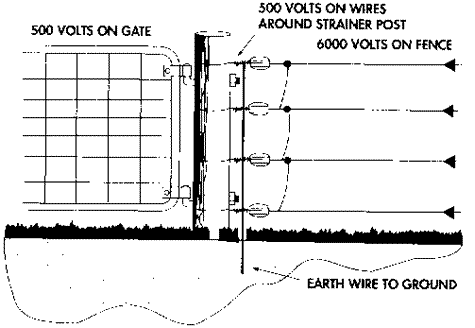FAULT FINDING
There are a number of reasons for reduced
voltage on the fence line.
- Vegetation growth
- Broken wires
- Corrosion
- Poor grounding
- Bad connections
- Poor insulation
- Increasing the length of fence
- TOOLS REQUIRED
The most important piece of equipment required
to check for faults is the Stafix Digital Voltmeter. With the Stafix
voltmeter you can pinpoint faults accurately.
Also:
- Wire strainers
- Pliers
- Adjustable wrench
- Joint clamps
FAULTS TO LOOK OUT FOR
- Is the energizer switched on?
Is the leadout wire connected to
the energizer and the fenceline? · Is there a break in
the leadout?
- Is the earth wire connected to the energizer
and earth rods?
- Is there a break in the earthwire?
- Are all the cutout switches turned on?
- Is there a dead short on the fenceline?
- Are there any faulty or broken insulators?
- Use the fault finding chart below to help
you locate faults.
Always check the voltage at the energizer
First.
To check if the energizer is faulty, disconnect
both the leadout and the ground wires and test the energizer without
any load. If the energizer is reading below the manufacturer's specification
there could be a fault with the energizer.
If the energizer is reading normal then:
- Check the Ground System before checking
the fenceline.
- Refer to the section on grounding in ENERGIZER
INSTALLATION.
- If no fault is discovered with either
the energizer or the ground system, then check the fenceline.
- The use of Stafix Cut Out Switches makes
the job of finding faults easier as different sections of the
fence can be isolated.
- When the area of fence which is at fault
is switched off, the voltage on the remainder of the fence will
rise.
- Once you have isolated the section of
fence at fault, move along the fenceline and take voltage readings
every 330ft.
- The readings will continue to drop until
you reach, or pass the fault. After the Fault, the readings should
remain constant. (Remember there may be more than one fault)
INDUCTION
A phenomenon known as induction is common with electric fences.
This is the transfer of electricity from an electrified wire to
a non electrified wire without the wires physically touching each
other. This is often mistakenly blamed on insulator leakage. This
phenomenon is also more common in areas where the air is damp such
as in conditions of fog.
As this phenomenon is a quirk of nature it
cannot be stopped from occurring. However, to avoid receiving shocks
caused by induction on non electrified fences and gates etc. you
can "ground out" the offending fence by connecting a ground
wire to all wires on the non electrified fence. Push the end of
this wire into the ground as far as possible and this will send
all the offending voltage into the ground.

NOTE: Induction has very little effect on
the voltage on the electrified fence.
RADIO INTERFERENCE
All Stafix Cyclic Wave™ energizers
comply with the usual regulations, but problems can occur for various
reasons, particularly in areas with poor radio reception. These
are usually noticed when an audible "click" is heard on
the radio and coincides with the pulsing of the energizer.
To reduce or eliminate the problem, look
for faults in the following areas:
- The energizer earth must be very good
and should be at least 33ft away from any other ground. No part
of the energizer ground system should come into contact with any
buildings.
- Avoid having any leadout wires or fencelines
running parallel to telephone or power wires.
- Check for any fence faults such as: broken
insulators, poor connections and joints, any shorting caused by
broken wires etc. Also check that cut out switches are not arcing.
- Check that no underground cable has been
damaged and is shorting out.
- Walking the fencelines with a portable
radio tuned off the station and on high volume is a quick and
easy way to locate any electrical leakage.
Start
Check the voltage reading at the energizer
Is the voltage lower than normal?
Yes
Is the voltage normal?
Yes
Has the fenceline been extended or added onto?
Yes
Check that the ground voltage is not greater than 300 volts (see
ENERGIZER INSTALLATION)
Yes
A larger energizer may be required but check the fenceline first
Upgrade your ground system (see ENERGIZER INSTALLATION)
Check the fenceline for possible shorting at:
Leadouts
Joints
Insulators
Vegetation growth
Accidental shorting

|











